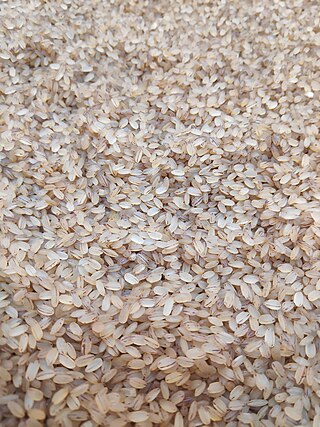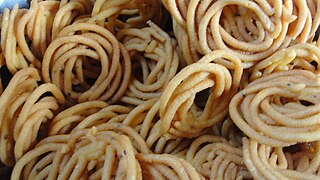This article needs additional citations for verification .(December 2006) |
Samba is a variety of rice grown in Tamil Nadu, some other parts of India and Sri Lanka, and has a small ovular grain, compared to the long grain of basmati rice. [1]
This article needs additional citations for verification .(December 2006) |
Samba is a variety of rice grown in Tamil Nadu, some other parts of India and Sri Lanka, and has a small ovular grain, compared to the long grain of basmati rice. [1]
Samba rice has a distinct taste and can be described[ who? ] as having a more 'starchy' or 'corny' flavor.And also liked by many as it tastes better than other rice and also it becomes less harder after cooking.[ citation needed ].
The grain itself is much harder than the other varieties and when cooked is less[ citation needed ] 'fluffy' in texture so gives a more filling[ citation needed ] meal with a higher[ citation needed ] caloric value.
All Samba rice grain is harvested locally by the mallas[ who? ] of India and there are many sub-varieties ranging in grain size and price. Seeraga Samba is the most expensive sub-variety and has the finest grain. It is approximately a third the size of a grain of basmati rice[ citation needed ].
Samba rice is grown extensively in the South Indian state of Tamil Nadu. Rice grown in Samba season (August through January) is referred to as Samba rice. [2] This rice is grown for a longer duration compared to other types of rice.[ citation needed ]
A subvariety of the Samba, known as the Seeraga Samba or Jeera Samba (in Tamil : சீரக சம்பா, which means 'Cumin samba', due to its resemblance to cumin seeds), is popular for consumption in south-east India. [3] It is exclusively cultivated along the Cauvery river and peculiarly in its delta, notably in the Vellapallam and Keevalur talukas of Nagapattinam district, Uppiliyapuram of Tiruchirappalli district and in various areas of Thanjavur district. [3] This subvariety was presented in 2018 by an association of farmers to benefit of a geographical indication (GI tag), the request is currently being processed. [3] [4]

Biryani is a mixed rice dish, mainly popular in South Asia. It is mainly made with rice, a choice of meat and lots of seasonings and spices. To cater to vegetarians in some cases, it is prepared by substituting vegetables or paneer for the meat. Sometimes eggs or potatoes are also added.

Basmati is a variety of long, slender-grained aromatic rice which is traditionally grown in the Indian subcontinent, mainly India, and Pakistan, as well as some regions of Sri Lanka and Nepal. As of 2019, India accounted for 65% of the international trade in basmati rice, while Pakistan accounted for the remaining 35%. Many countries use domestically grown basmati rice crops; however, basmati is geographically exclusive to certain districts of India and Pakistan.

Vellore district is one of the 38 districts in the Tamil Nadu state of India. It is one of the eleven districts that form the north region of Tamil Nadu. Vellore city is the headquarters of this district. As of 2011, the district had a population of 1,614,242 with a sex ratio of 1,007 females for every 1,000 males. In 2017 Vellore district ranked eleventh in list of districts in Tamil Nadu by Human Development Index.

Spiced rice is a rice-based dish flavored with various types of spice. Spiced rice is common around the world, with one of the most notable dishes being Indian Ghee rice, which uses ghee butter as a primary ingredient.
Ambemohar is a fragrant rice variant grown in the foothills of the Western ghats region of the state of Maharashtra in India.

Matta rice is an indigenous variety of rice grown in Udupi and Dakshina Kannada districts of Karnataka, Palakkad district of Kerala, India and in Jaffna district of Northern Province, Sri Lanka. It is known for its coarseness and health benefits. It is popular in Kerala and coastal Karnataka in India and Sri Lanka where it is used on a regular basis for idlies, appams and plain rice.

Muṟukku is a savoury, crunchy snack originating from the Indian subcontinent. The name muṟukku "twisting" refers to its shape.

Tulaipanji is an Indian rice cultivar from West Bengal, India. It is an indigenous aromatic rice grown mainly in the Raiganj subdivision of Uttar Dinajpur district and some pockets of Dakshin Dinajpur district. In 2012, the Government of West Bengal sent Tulaipanji rice to the food festival at the London Olympics.

Kalanamak is a scented rice of Nepal and India. Its name means black husk. This variety has been in cultivation since the original Buddhist period. It is popular in Himalayan Tarai of Nepal i.e., Kapilvastu, and eastern Uttar Pradesh, where it is known as the scented black pearl. It was featured in the book Speciality rices of the world by Food and Agriculture Organization of the United Nations.
Katarni rice is a unique tasting, aromatic, short grain rice grown in India, in the state of Bihar. Grown natively in the Bhagalpur and Banka districts, Katarni rice is not only in demand in Bihar, but throughout the country.
Manapparai Murukku is a variety of murukku, a traditional Indian snack from the town of Manapparai in Tiruchirappalli district in the state of Tamil Nadu.
Ajara Ghansal is a variety of non-Basmati aromatic rice mainly grown in the Indian state of Maharashtra. It is a common and widely cultivated crop in Ajara taluka of Kolhapur district.
Balaghat Chinnor is a variety of non-Basmati aromatic rice mainly grown in the Indian state of Madhya Pradesh. It is a common and widely cultivated crop in tehsils of Balaghat, Baihar, Birsa, Paraswada, Katangi, Waraseoni, Lalbarra, Khairlanji, Lanji and Kirnapur of Balaghat district
Bhandara Chinoor rice is a variety of non-Basmati aromatic rice mainly grown in the Indian state of Maharashtra. It is a common and widely cultivated crop in talukas of Bhandara, Pauni, Tumsar, Mohadi, Sakoli, Lakhani, and Lakhandur of Bhandara district.
Kalonunia rice is a variety of non-Basmati, aromatic, black textured small rice mainly grown in the Indian state of West Bengal. It is a common and widely cultivated crop in districts of Cooch Behar, Jalpaiguri and Alipurduar along with some parts of Darjeeling & Kalimpong districts of West Bengal.

Mushqbudji rice is a variety of non-Basmati, short-grained aromatic rice mainly grown in the Indian Union territory of Jammu and Kashmir growing on the higher reaches of the valley. It is a common and widely cultivated crop in Sagam belt of Anantnag district and the Beerwah belt of Budgam district, and also cultivated in Anantnag and Kulgam in Kashmir by farmers under irrigated conditions.
Marcha rice is a variety of non-Basmati, short-grained aromatic rice mainly grown in the Indian state of Bihar. It is a common and widely cultivated crop in Ramnagar, Gaunaha, Mainatand, Chanpatiya, Narkatiyaganj and Lauriya blocks of West Champaran district.
Koraput Kalajeera rice is a variety of non-Basmati, aromatic, black paddy coloured, small rice mainly grown in the Indian state of Odisha. It is a common and widely cultivated crop in the Koraput district of Odisha as well as Nabarangapur district which was earlier a part of Koraput. For thousands of years, the ancestors of Koraput's present tribal communities have cultivated and domesticated Kalajeera rice, playing a crucial role in its conservation.
Adamchini Chawal is a variety of non-Basmati, traditional, short-grained aromatic rice mainly grown in the Indian state of Uttar Pradesh. It is a common and widely cultivated crop in Chandauli, Mirzapur, Varanasi and Sonebhadra, and Vindhya region of Eastern Uttar Pradesh.